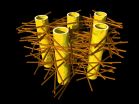Finding hope in the dark
2015-06-10
(Press-News.org) Advances in stem cell transplantation and gene therapy have been pioneered in vision research. An international team of researchers from Bristol, Toronto, Pittsburgh, Dallas and Montreal have identified a gene that could be responsible for some cases of human night blindness.
Leber's congenital amaurosis (LCA) is a group of hereditary retinal diseases that result in severe loss of vision in early childhood and is estimated to affect around 1 in 80,000 of the population. Recent clinical trials of gene therapy for LCA have shown early promising results in treated patients although their improvements in vision appear to be temporary. Similarly, stem cell transplantation in patients with a range of inherited and acquired retinal disorders is currently undergoing clinical trials and the results are eagerly anticipated after encouraging results in animal models.
The research team recently identified a gene PRDM8 that is also linked to the early loss of night vision in animal models. Often genes that affect the function or survival of the principal light-sensitive cells in the retina, the rod and cone photoreceptors, are responsible for early onset night blindness.
In contrast, PRDM8 appears to influence the inner neural circuitry of the retina that connects the photoreceptors with the rest of the central nervous system. PRDM8 affects the survival of neurons within this retinal circuitry so that they are permanently lost. Consequently, signals from the photoreceptors are not processed correctly through the circuitry of the inner retina causing night blindness.
Dr Denize Atan, Consultant Senior Lecturer in Ophthalmology from the University of Bristol's School of Clinical Sciences and first author on the paper, said: "Our findings suggest that PRDM8 might be responsible for some cases of human night blindness and that PRDM8 is a potential candidate for gene therapy. In addition, our discovery of the importance of this gene to inner retinal circuitry could help researchers in their efforts to generate these neurons for transplantation studies."
INFORMATION:
Paper
'Transcription factor PRDM8 is required for rod bipolar and type 2 OFF-cone bipolar cell survival and amacrine subtype identity' by Cynthia C. Jung*, Denize Atan*, David Ng, Lynda Ploder, Sarah E. Ross, Martin Klein, David G. Birch, Eduardo Diez and Roderick R. McInnes [*co-first authors] in Proceedings of the National Academy of Sciences (PNAS).
ELSE PRESS RELEASES FROM THIS DATE:
2015-06-10
This news release is available in French. In an article published in the journal Environment International, researchers from Inserm (Inserm Unit 1085 - IRSET, the Institute of Research in Environmental and Occupational Health, Rennes), in association with the Laboratory for Developmental and Educational Psychology, LPDE (Rennes 2 University), provide new evidence of neurotoxicity in humans from pyrethroid insecticides, which are found in a wide variety of products and uses. An increase in the urinary levels of two pyrethroid metabolites (3-PBA and cis-DBCA) in children ...
2015-06-10
ANN ARBOR, Mich. - It started out as a treatment for arthritis. But steered by science, it could become a first new approach in two decades for treating the damage that diabetes inflicts on the kidneys of millions of people.
This past weekend, University of Michigan Medical School researchers and their colleagues presented promising results from a clinical trial of the experimental drug baricitinib in people with diabetic kidney disease. In a randomized, controlled Phase II study, it reduced a key sign of kidney damage, with higher doses producing the largest effect, ...
2015-06-10
Many cancer patients survive treatment only to have a recurrence within a few years. Recurrences and tumor spreading are likely due to cancer stem cells that can be tough to kill with conventional cancer drugs. But now researchers have designed nanoparticles that specifically target these hardy cells to deliver a drug. The nanoparticle treatment, reported in the journal ACS Nano, worked far better than the drug alone in mice.
Anti-cancer drugs can often shrink tumors but don't kill cancer stem cells (CSCs). Although CSCs might only make up a small part of a tumor, their ...
2015-06-10
As many of the world's nations prepare and implement plans to cut greenhouse gas emissions, researchers say another critical factor needs to be considered. A new study has found for the first time that efforts to keep global temperatures in check will likely lead to more people going hungry. That risk, they say in the ACS journal Environmental Science & Technology, doesn't negate the need for mitigation but highlights the importance of comprehensive policies.
Previous studies have shown that climate change reduces how much food farms can produce, which could lead to ...
2015-06-10
When Typhoon Haiyan slammed into the Philippines in 2013, thousands of people were killed, in part because they didn't know it was coming or didn't know how to protect themselves.
Could an increased use of social media, particularly on the part of the nation's government, have made a difference?
While that question remains open, it is clear that social media should play a larger role in emergency preparedness, says Bruno Takahashi, a Michigan State University assistant professor of journalism who studies the issue.
Using the Philippines' typhoon as a case study, Takahashi ...
2015-06-10
Although the Universe may seem spacious most galaxies are clumped together in groups or clusters and a neighbour is never far away. But this galaxy, known as NGC 6503, has found itself in a lonely position, shown here at the edge of a strangely empty patch of space called the Local Void. This new NASA/ESA Hubble Space Telescope image shows a very rich set of colours, adding to the detail seen in previous images.
NGC 6503 is only some 18 million light-years away from us in the constellation of Draco (The Dragon), making it one of the closest neighbours from our Local Group. ...
2015-06-10
The stuffy noses and sinus pressure of head colds are uncomfortable, but for most people, they go away within days. For those with chronic sinusitis, however, those symptoms and others drag on for weeks. Now scientists are onto a potential new therapy that could address one of the underlying factors associated with the condition. They describe their work in the ACS journal Molecular Pharmaceutics.
In the body, nitric oxide (NO) plays a critical role in immunity. Researchers have found that this simple molecule is an important antimicrobial agent that helps prevent sinus ...
2015-06-10
To some scientists studying climate change, boreal peatlands are considered a potential ticking time bomb. With huge stores of carbon in peat, the fear is that rising global temperatures could cause the release of massive amounts of CO2 from the peatlands into the atmosphere--essentially creating a greenhouse gas feedback loop.
A new study by researchers at the University of South Carolina and University of California Los Angeles challenges that notion, and demonstrates that the effect of temperature increases on peat storage could be minor.
Funded by the National ...
2015-06-10
This news release is available in German.
Human teeth have to serve for a lifetime, despite being subjected to huge forces. But the high failure resistance of dentin in teeth is not fully understood. An interdisciplinary team led by scientists of Charite Universitaetsmedizin Berlin has now analyzed the complex structure of dentin. At the synchrotron sources BESSY II at HZB, Berlin, Germany, and the European Synchrotron Radiation Facility ESRF, Grenoble, France, they could reveal that the mineral particles are precompressed.
The internal stress works against crack ...
2015-06-10
Chicago, June 10, 2015 - Patients diagnosed with an advanced form of metastatic non-small cell lung cancer (NSCLC) may benefit from surgical resection (removal of all or part of the lung) in combination with chemotherapy and radiation therapy, according to an article in the June 2015 issue of The Annals of Thoracic Surgery.
Key points
Patients diagnosed with stage IIIB NSCLC may benefit from multimodality treatment that combines surgical resection in combination with chemotherapy or radiation therapy.
Surgery should be added to the treatment regimen only for carefully ...
LAST 30 PRESS RELEASES:
[Press-News.org] Finding hope in the dark

